
We are excited to introduce our new Advertising & Media Committee!
As part of our ongoing efforts to streamline member engagement and enhance focus on key industry priorities, we are evolving two of our existing committees and expanding our work in commerce media to provide our members with even more opportunities to get involved.
To ensure a more cohesive approach to addressing our industry’s challenges, we are evolving the Brand Advertising Committee and Programmatic Trading Committee into a single entity: the Advertising & Media Committee.
This new committee will serve as a central forum for collaboration, uniting industry leaders to tackle the most pressing commercial and technological trends in European digital advertising and media. It will be structured as one main committee with four specialised sub-groups, each dedicated to key industry topics:
Through these workstreams, the committee will drive industry growth and innovation by:
With the rapid evolution of retail media and the expansion of commerce media networks, we are also updating the Retail Media Committee to the Retail & Commerce Media Committee. This change reflects the broader landscape that now encompasses commerce-driven media strategies beyond traditional retail advertising.
We invite all interested members to register their interest for the Advertising & Media Committee and its sub-groups by completing this form.
The first committee meeting, where we will discuss the election of a Chair and Vice-Chair, along with the 2025 workplan, will take place at the end of March.
To provide further insights into the committee’s objectives and workplan for 2025, IAB Europe will be hosting a Virtual Members Townhall on Wednesday, 26th March at 12:00 PM CET. This session will also cover all IAB Europe committee work plans for 2025.
Members can register to attend here.
We look forward to working closely with our members to ensure this new structure delivers meaningful outcomes for the industry. Your engagement is invaluable in shaping the future of digital advertising and media in Europe.

Join us on 20th-21st May 2025 in Brussels for our annual flagship conference Interact - the event that unites leaders from across the digital advertising and marketing industry.
This year’s theme, ‘Digital Skylight – Clarity and Purpose for 2025 and Beyond’, reflects the need for clear direction in an ever-evolving digital landscape. With shifting regulations, economic uncertainty, and rapid technological advancements, staying informed and inspired has never been more important.
At Interact 2025, top industry experts, advertisers, publishers, and policymakers will come together to share insights, explore the latest trends, and shape the future of digital advertising. Through a curated programme of high-level keynotes, expert panels, and interactive discussions, we’ll examine the economic, social, and industry forces at play— - leaving you with not just knowledge, but a renewed sense of clarity and purpose for the year ahead.
Don’t miss your chance to secure your spot at a discounted rate before 29th March.
If you haven’t experienced Interact before, check out our 2024 Wrap Blog, and Highlights Reel, to see what makes this an event not to be missed.
If you're interested in sponsoring Interact 2025, contact our CMO, Helen Mussard, at mussard@iabeurope.eu to discuss opportunities.
Stay tuned for more updates on the agenda and speaker lineup on our event page here.
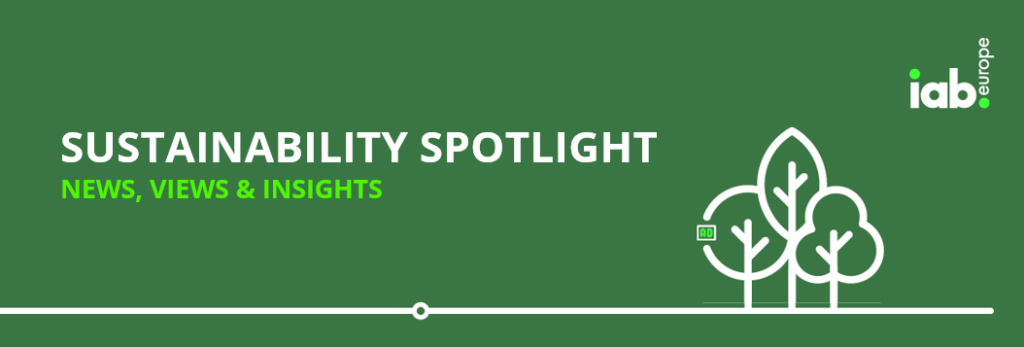
Sustainability remains a key priority for the digital advertising industry, and at IAB Europe, we’re committed to providing the latest insights, best practices, and expert guidance to help drive meaningful change.
In this Sustainability Spotlight, we highlight inspiring case studies from across the industry, opportunities to enhance your sustainability expertise, and the latest research shaping the conversation. Plus, don’t miss our upcoming Great Debate, where industry leaders will tackle the most pressing sustainability challenges and solutions.
For a comprehensive collection of sustainability resources, be sure to visit our Sustainability Hub.
Read on to explore the latest updates and stay ahead in the sustainability conversation.
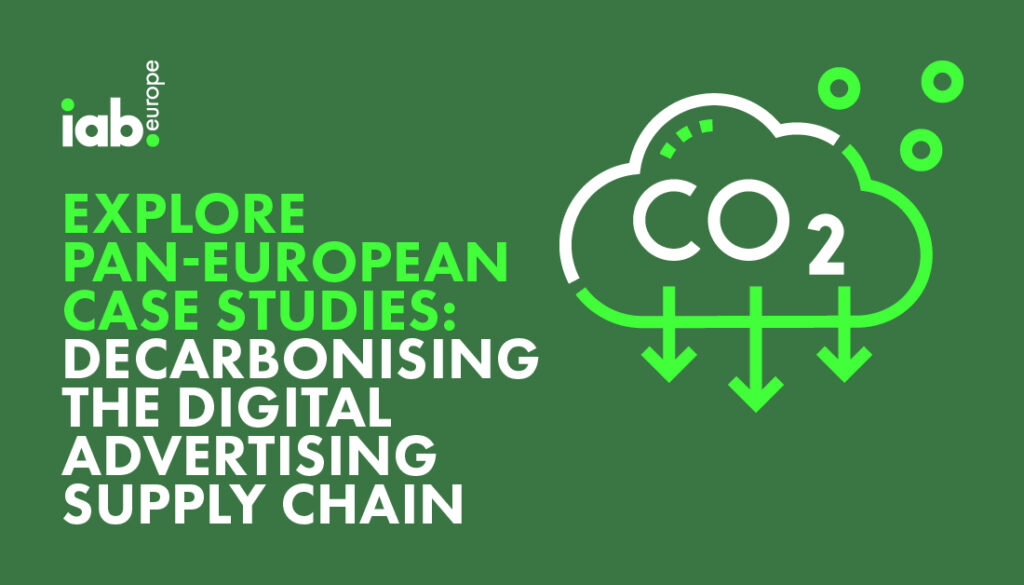
Sustainability is a crucial challenge for our industry, with companies actively seeking ways to reduce their environmental impact. To support these efforts, we’re excited to release our Pan-European Case Studies Programme, showcasing real-world sustainability initiatives.
From decarbonising the supply chain to innovative strategies for reduction, these case studies highlight best practices driving industry-wide change.
Featuring best practices from PubMatic, Impact Plus, Cedara, Footsprint and more, explore the case studies below and get inspired!
You can also join our webinar on 12th March for a deeper dive into some of these initiatives here.
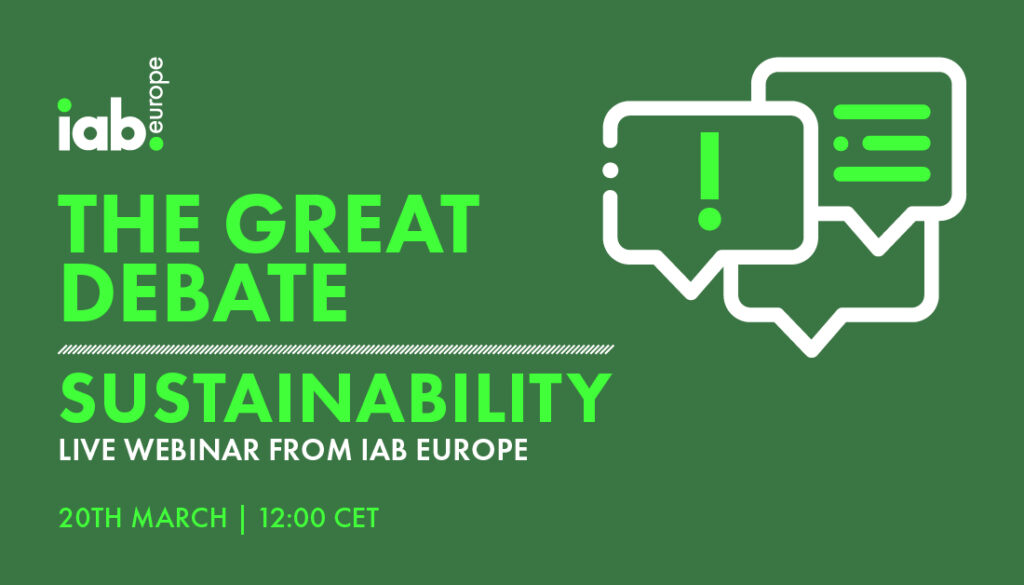
Join us on 20th March for our Great Debate: Sustainability, where industry experts will come together to tackle key topics such as how progress in environmental sustainability is being driven, how digital media can accelerate social impact, and more. Expect keynotes, panels, and actionable insights on building a sustainable digital advertising ecosystem for all.
Stay tuned for the full agenda - secure your spot today!
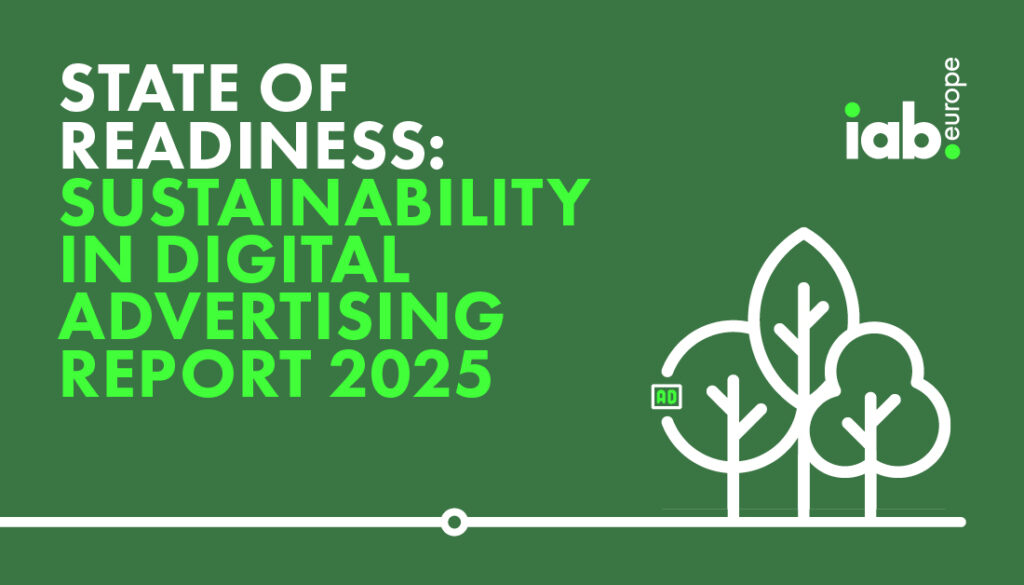
Discover the latest insights on sustainability in digital advertising in our latest State of Readiness Report. Now in its third year, the report reveals the industry's progress, priorities, and challenges in building a more sustainable future.
Download the full report below and explore key findings, including the increase in companies setting Science-Based Targets (56%) and the doubling of emissions measurement since 2024!
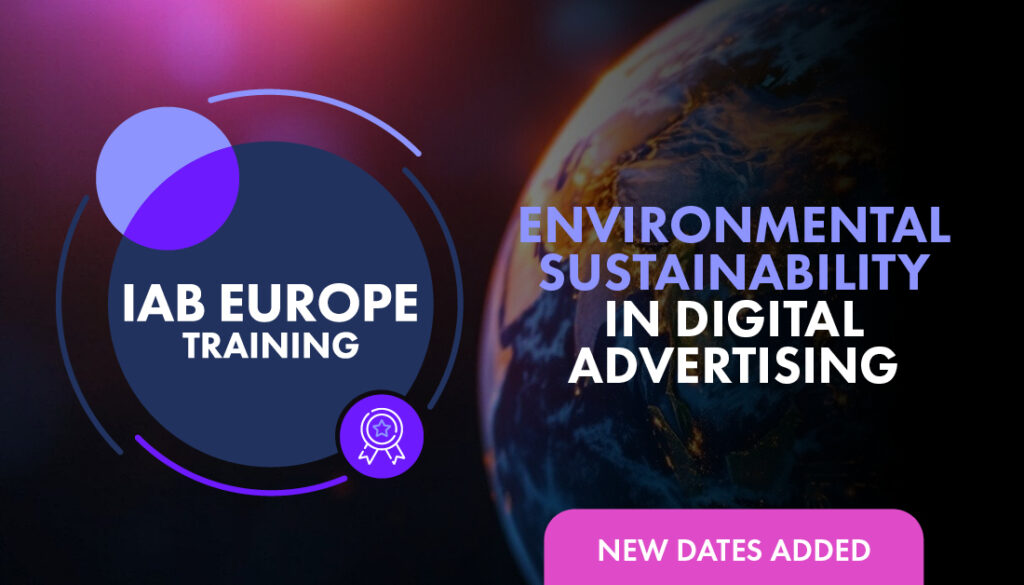
New dates added! Join one of the next editions of our five-session online courses on environmental sustainability in digital advertising. Gain essential insights, practical strategies, and expert guidance to reduce emissions and drive sustainable change across the industry. This is a must-attend for all professionals looking to make a real impact.
Available courses:
Are you an IAB Europe member and a digital advertising expert with valuable insights to share? Why not join us as a guest on one of our podcasts.
From Digital Dawn to Retail Media Essentials, Policy Matters and more, our podcast series bring industry insights to life, sparking new ideas and driving meaningful discussions. In each episode, an IAB Europe team member sits down with at least one special guest to explore the latest trends, challenges, and opportunities shaping the future of digital advertising.
Join the conversation and help shape the industry’s path forward!
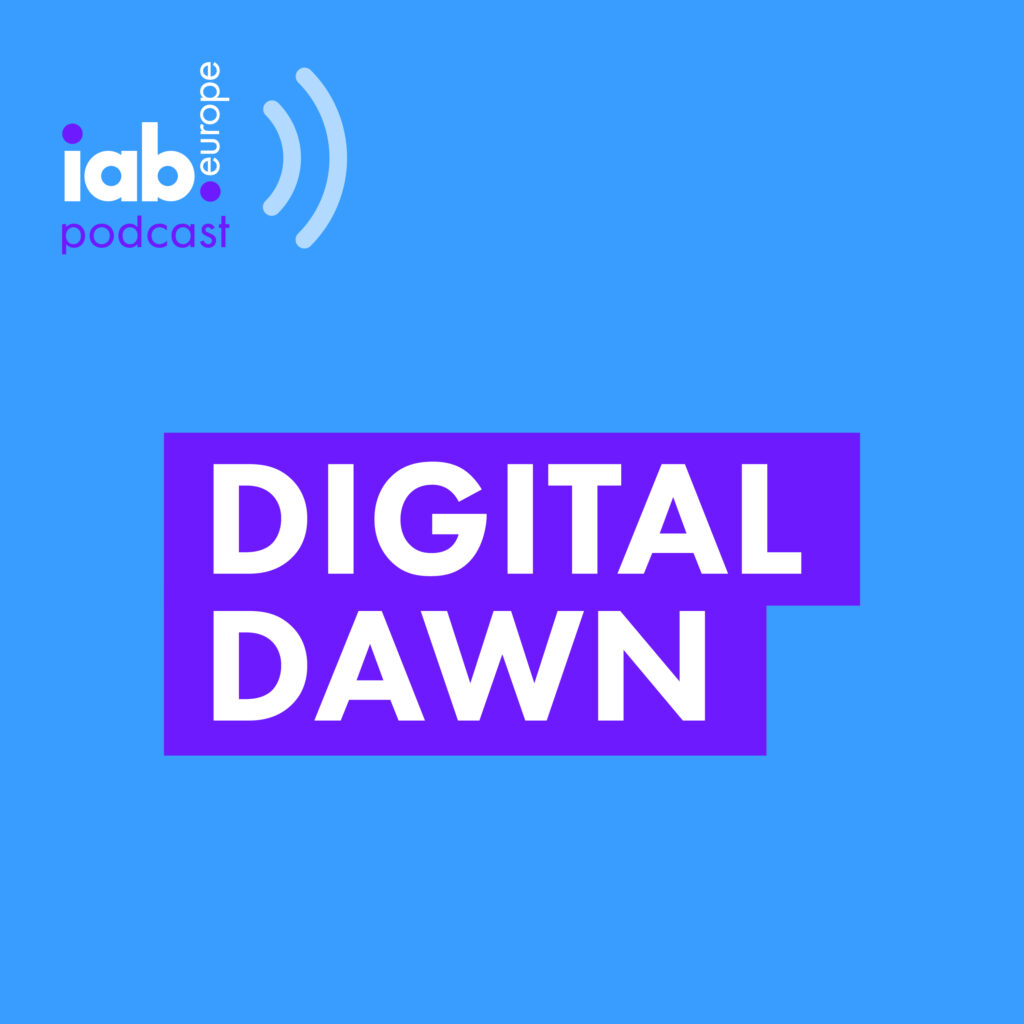
Our original podcast series invites guests from all corners of the digital advertising ecosystem to share their thoughts and insights on a wide range of topics. Whether you want to discuss emerging trends like AI, dive deep into exciting channels like CTV, or explore how we can drive career development or DE&I in our industry we are open to the ideas you want to share.
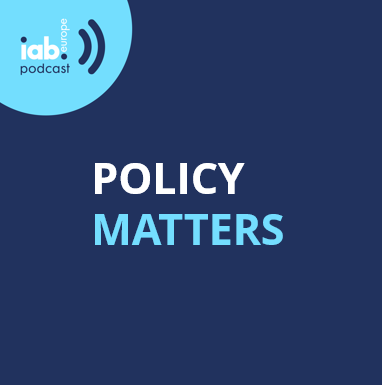
Brought to you by IAB Europe’s Policy team, Policy Matters dives into European regulation and the policies impacting the digital advertising industry. Delivering in-depth conversations with experts, policymakers and thought-leaders it explores the nuances of policy decisions, the ripple effects they create, and potential solutions that can drive positive change.
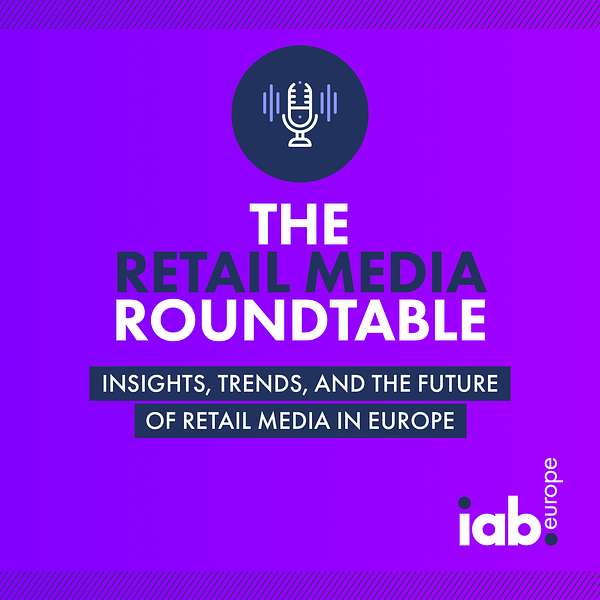
Launched in January 2025, this new podcast mini-series dived into the dynamic world of Retail Media advertising. Each episode saw two expert guests from across the industry share their insights, exchange ideas, and explore the latest trends and challenges shaping the Retail Media landscape in Europe.
Given the great success of the first series, we’re looking for people interested in participating in another short series in Q2.
We’re always looking for passionate industry leaders to join our episodes. If you have insights, success stories, or exciting opportunities to discuss, we’d love to hear from you
Let us know which series you’re interested in participating in, and leave the rest to us.
Contact our Marketing & Communications Director, Lauren at wakefield@iabeurope.eu to find out more about how you can get involved today.
Listen to our podcasts here!

Ranked as the second most critical challenge for the digital advertising industry in our 2025 State of Readiness Report, sustainability is a growing priority, with companies across the ecosystem actively exploring ways to reduce their environmental impact.
To help highlight and accelerate these efforts, we are excited to reveal our Pan-European Case Studies Programme - a programme dedicated to showcasing real-world examples of sustainability in action. Bringing together case studies from various companies across Europe, the initiative focuses on the decarbonisation of the supply chain and other impactful sustainability initiatives.
By sharing these best practices, innovative strategies, and successful implementations, we aim to educate, inspire, and drive industry-wide change.
Check out the case studies below!
If you would like to know more about our case study programme and how you can participate, please contact Colombe at michaud@iabeurope.eu.
Discover more about IAB Europe’s sustainability initiatives here and connect with our Sustainability Lead Dimitris Beis at beis@iabeurope.eu to learn about membership opportunities and how to get involved.
68% of respondents think the industry should consider the carbon footprint of the consumption it drives
Nearly half (48%) of businesses are now estimating the emissions produced by digital media products
Brussels, Belgium, 19th February 2025 - IAB Europe, the European-level industry association for the digital marketing and advertising ecosystem, today announced the results of its latest annual ‘State of Readiness - Sustainability in Digital Advertising’ Report for 2025. Now in its third year, the report provides key insights into the industry’s sustainability priorities, actions taken to reduce carbon footprints, and the progress made towards more sustainable practices across Europe.
Based on 102 responses from companies in the digital advertising ecosystem across Europe, the report reveals that the majority of businesses (74%) see sustainability as a vital component of their business models. The number of companies that have set Science-Based Targets (SBTs) has also seen significant progress, increasing by 56% from 18% in 2024 to 28% in 2025.
The report also reveals the need for a multidimensional approach for continued progress in environmental sustainability. It emphasises the need for key actions, with respondents strongly agreeing/agreeing that greenhouse gas (GHG) estimation (90%), the creation of consistent standards for GHG estimation (89%), and the development (90%) and adoption (92%) of tools to reduce emissions are needed, to drive meaningful change.
Key findings from the 2025 State of Readiness Report highlight:
Commenting on the findings, Townsend Feehan CEO of IAB Europe said "The 2025 findings show encouraging progress, with more companies setting science-based targets and actively measuring their environmental impact. However, our industry still requires greater collaboration, consistent standards, and continued investment to drive meaningful change. IAB Europe remains committed to supporting the industry in accelerating its sustainability journey.”
Anthony Falco, Global Director at Ad Net Zero also commented, “It’s clear that standardisation of GHG emissions measurement is required to accelerate reductions across the digital advertising landscape, and the development of Global Media Sustainability Framework(GMSF) is an important part of this. As more companies prioritise sustainability, in part to comply with regulatory requirements, standardisation can help create real, positive change for the industry.”
IAB Europe’s Sustainability Standards Committee is a multi-stakeholder group that shares insights and delivers outputs that help reduce the amount of energy consumed and emissions produced by digital advertising. The findings from this year’s report will help drive the committee’s work for the year ahead.
For more information about IAB Europe’s sustainability initiatives, visit the IAB Europe Sustainability Hub here. To learn more about membership opportunities and how to get involved, please contact communication@iabeurope.eu.
The full report with accompanying graphs can be downloaded from IAB Europe’s website here.

Our Marketing & Communications Director, Lauren Wakefield, shares her thoughts on our Advertising Horizons policy event, and how policy, trust, and innovation are shaping the future of digital advertising.
As a marketer who spends most of my time on the industry side, stepping into the world of digital advertising policy in Europe at Advertising Horizons 2025 in Brussels for a whole day felt like opening a door to an exciting extra dimension. With policy usually featured as a section within our wider events, it was refreshing to spend a day dedicated to diving into how innovation, policy, and trust intertwine to shape the future of our industry.
What struck me the most was the emphasis throughout the day on trust and transparency as the foundation of digital advertising’s evolution. In a landscape where consumer expectations are rapidly changing, discussions around privacy, data ethics, and transparency were not just regulatory checkboxes - they were at the heart of building sustainable marketing strategies. Hearing industry leaders debate the implications of the Digital Services Act (DSA) and the evolving ePrivacy regulations highlighted how essential it is for our industry to be proactive, not reactive, to policy shifts.
The event also showcased innovation as a catalyst for growth. From the rise of AI-driven ad technologies to the expansion of Retail Media Networks, the future of digital advertising is rich with possibilities, which as a marketer, I am pretty thrilled about. But these innovations come with a caveat. They must be aligned with responsible data practices and ethical considerations, and this balance between creativity and compliance is where the true challenge (and opportunity) lies.
Finally, what resonated most was the call for cross-industry collaboration. Something that is at the heart of what we do at IAB Europe. Navigating the complexities of European digital policy isn’t a solo journey. It requires the whole ecosystem - from marketers and policymakers to tech platforms, publishers, advertisers, and more to work hand in hand. The insights from the panel discussions and keynotes weren’t just anecdotal; they offered actionable strategies to bridge the gap between policy understanding and practical execution.
For me, Advertising Horizons 2025 wasn’t just another industry event. It was a refreshing opportunity to explore policy in greater depth and it underscored the importance of staying informed, engaged, and adaptable in an evolving European climate if we want to get ahead. The future of digital advertising isn’t just being shaped by algorithms and creative ideas - it’s being crafted through the lens of policy, trust, and purposeful innovation.
If you’d like to dive deeper into European digital advertising policy, you can check out our event wrap-up here. You can also reach out to the team at communication@iabeurope.eu, for more information on IAB Europe’s policy work and how you can get involved.
In the meantime, I’m excited to see what comes next as we navigate and advocate for our industry in this new EU term.

That’s a wrap! On the 4th of February 2025, digital advertising EU policy took centre stage in Brussels at our first dedicated policy event Advertising Horizons 2025.
With over 150 people in attendance, we saw European industry leaders, innovators, and policymakers come together to explore the future of our industry, delving into integral policy matters that will shape the road ahead.
Featuring exclusive panel sessions with policymakers and industry experts, quick-fire lightning talks, case studies, and more it was a day filled with powerful insights, practical takeaways, and all-important opportunities to connect with peers and the “EU bubble”.
The agenda covered key issues such as digital skills, the EU’s digitisation gap, consumer protection policies, and data protection.
Throughout the sessions, speakers highlighted the vital role of digital advertising:
To help you relive the event and explore the key insights from the day, we've put together a Recap Video alongside overviews of our standout sessions below, complete with top takeaways and on-demand videos for you to watch in your own time.
Watch the Recap Video here.
Enjoy!
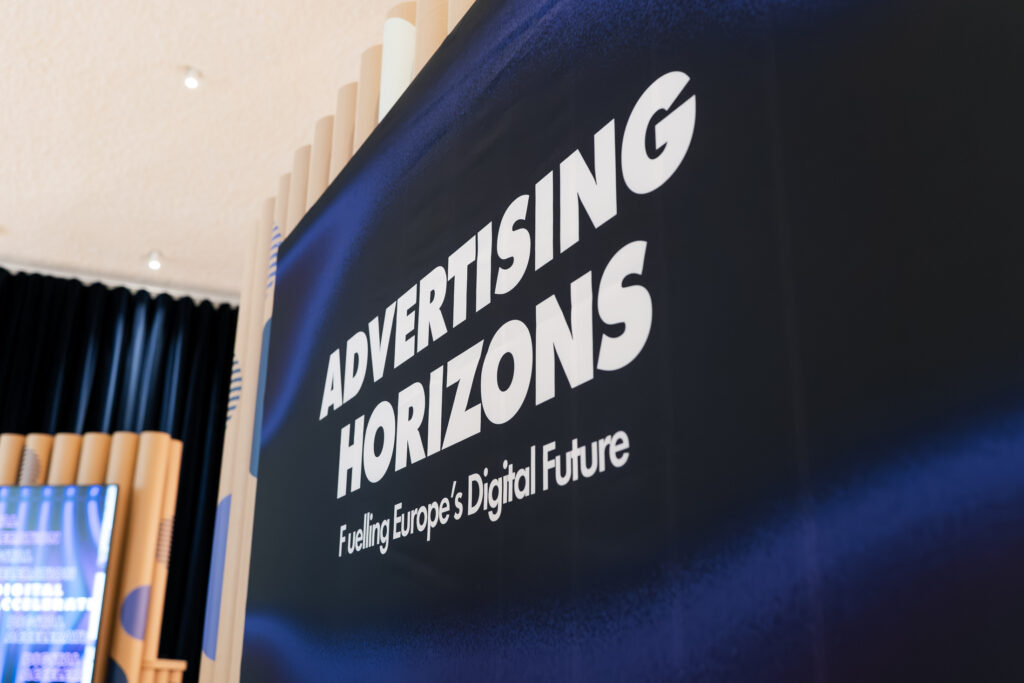
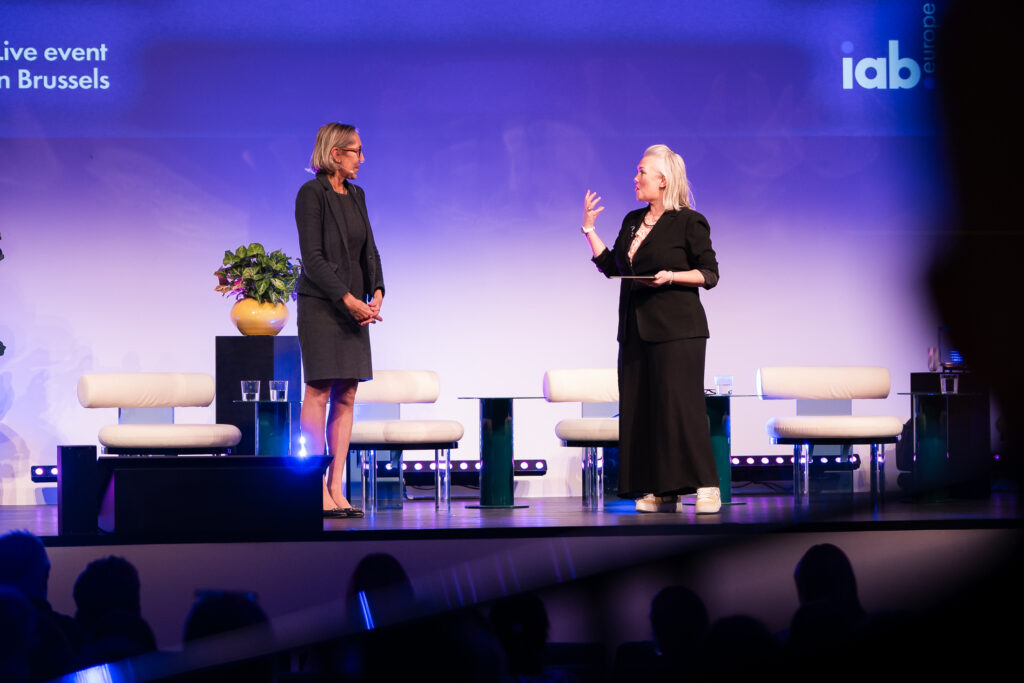
The event began with our CEO, Townsend Feehan, taking to the stage to set the tone for the day’s discussions. In her opening remarks, she described the event as an invitation to all to explore the benefits digital advertising brings to Europe’s society and economy, the hard facts that must be acknowledged and overcome, and the opportunities it offers to enhance competitiveness and accelerate the future of the EU.
“Today’s event is an invitation. An invitation extended to everyone who wants Europe’s internet to reflect its values – values such as equity, freedom, peace, democracy, and sustainability. The invitation is to explore with us the benefits that digital advertising brings to Europe’s society and economy, the challenges that accompany those benefits, and the opportunity it provides to advance the strategic autonomy and competitiveness goals that top the new Commission’s agenda.”
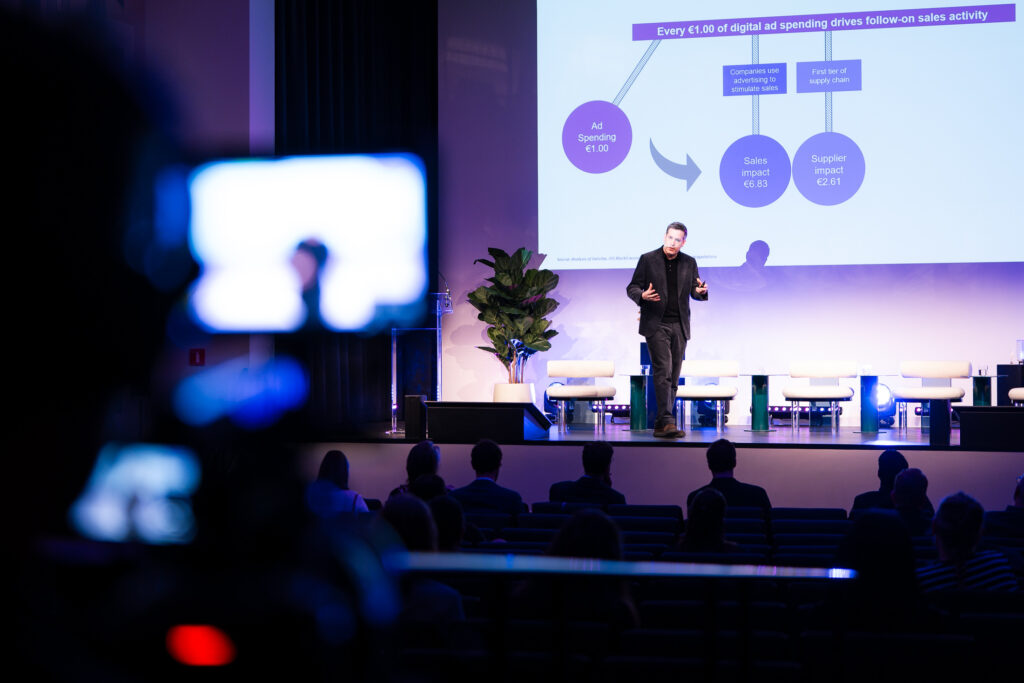
“It’s time to restart Europe’s innovation engine” - EU Chief Ursula von der Leyen
Following the opening remarks from our CEO, Daniel Knapp took to the stage to discuss the roles of innovation and creativity in driving our industry forward.
Here are some of the top takeaways from the session:
Watch the session recording here.
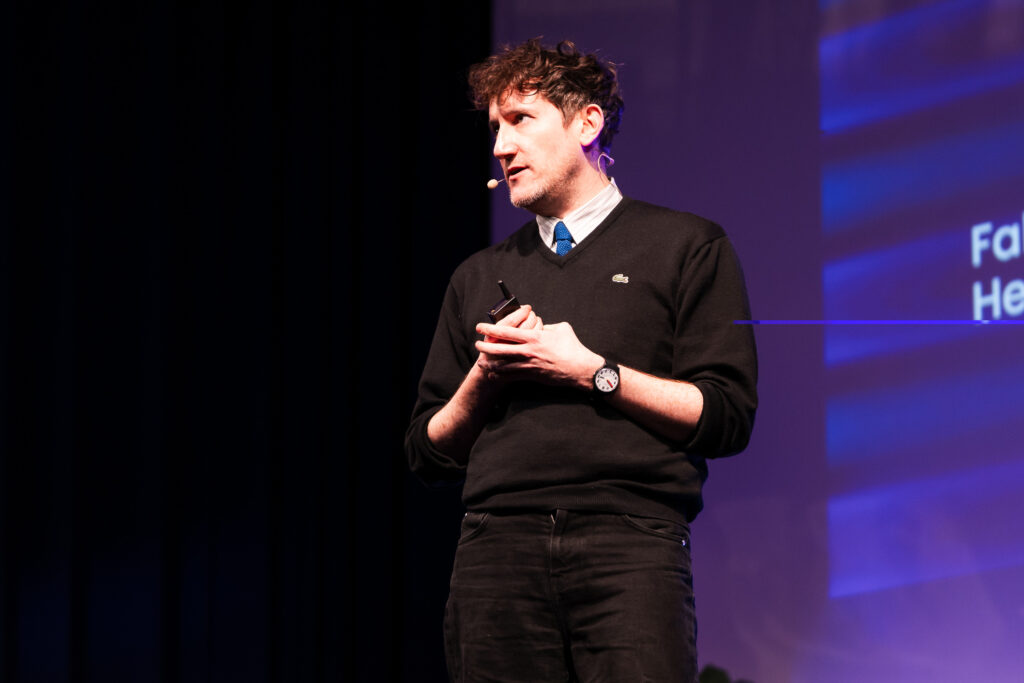
Next up, Fabien Le Roux, Head of Creative Department at TikTok talked us through the power of creativity in driving innovation. He discussed how TikTok is reshaping the entertainment category by prioritising creativity. This ranges from simple visuals to ideas that unlock new ways of engaging audiences.
With creators now replacing traditional influencers as the new currency of entertainment, TikTok provides a good example of how new technologies can drive significant economic growth for small businesses and help fuel both creative industries and advertising by bringing bold ideas back to the forefront.
Watch the session recording here.

Our first panel looked to tackle the digital skills gap in Europe. Moderated by VIA Netherlands’ Director, Saskia Baneke, the following panellist looked to bridge the gap between the digital skills available today and what is needed to drive the future of our industry tomorrow:
Here are the main highlights from this session:
Watch the session recording here.
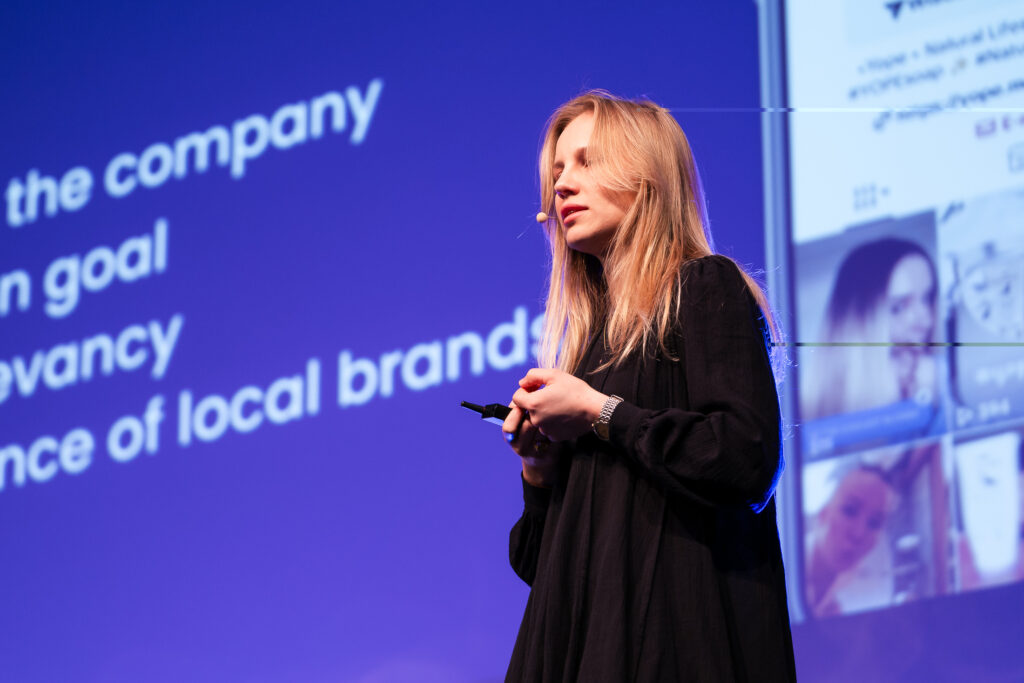
After a short coffee break, we were straight back into some great content with a case study from Teresa Solman, Digital Media Team Leader at Allegro, and Martyna Dziubek, Head of Marketing & NPD at Yope. The duo demonstrated how the two companies worked together to make the local Polish brand more marketable, utilising smart optimisation and personalisation through Retail Media to communicate key messages directly and transparently.
Watch the session recording here.
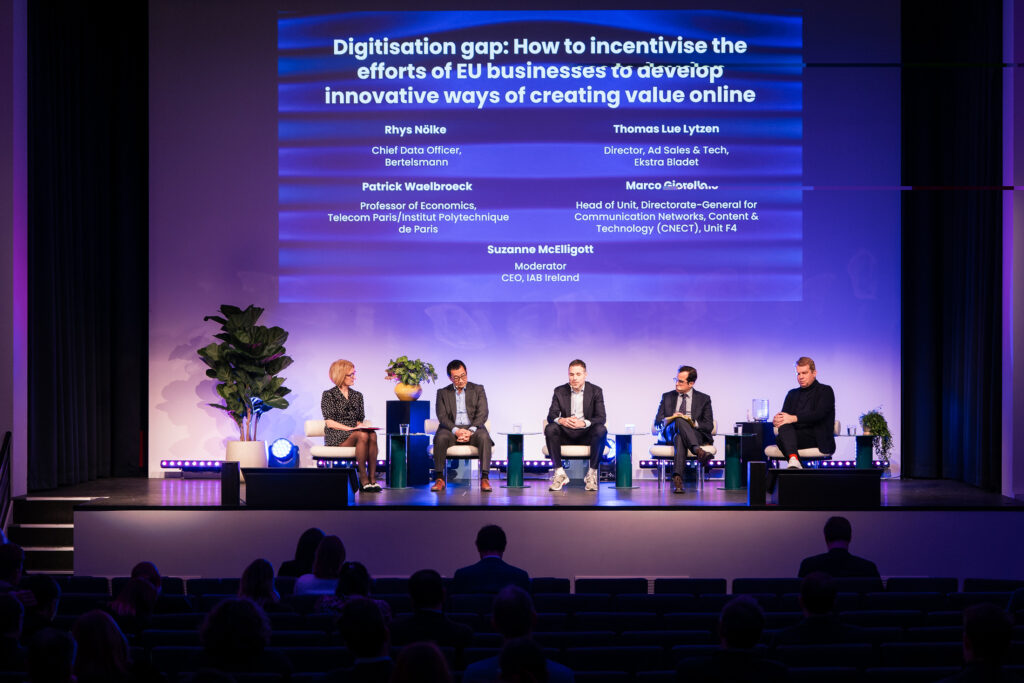
Our next panel took to the stage to discuss how we can encourage businesses in Europe to develop greater value in the online world through innovation and collaboration. Moderated by IAB Ireland’s CEO, Suzanne McElligott, the panel of speakers included:
Here are some of the top points discussed during this session:
Watch the session recording here.

We then moved the conversation to focus more on the benefits of personalisation to consumers and businesses in Europe. Moderated by Jacob Dexe, Public Affairs Manager at IAB Sweden, the following panellists discussed personalised advertising and how regulatory and trust-related challenges can influence its effectiveness.
Check out the main takeaways from this session:
Watch the session recording here.

It was then time to shift gears back to creativity. Welcoming to the stage Shahnaz Ahmed, Director of Creative and Innovation from The Social Element agency, the audience saw how creative campaigns can influence people to do more.
During the session, she shared several creative advertising examples that didn’t need big moments to make an impact. From the Assume I Can So Maybe I Will campaign that highlighted and supported those with Down Syndrome, to fictional characters that encouraged meat eaters to take on a more vegetarian lifestyle, we saw how putting the ‘What If’ and creativity at the centre of campaigns can move very human problems into measurable impact for brands.
Watch the session recording here.

From creative examples to battling bots. Jack Smith, Chief Innovation Officer at DoubleVerify then took us through the current status of ad fraud and ways in which this challenge can be addressed. He emphasised that industry collaboration was important in this area and that we all need to spot the anomalies as they appear to protect advertisers.
Watch the session recording here.

The final panel of the day, saw Matthew Newman, Global Chief Correspondent at MLex lead a discussion on how the industry can work with policymakers to ensure privacy and innovation are achieved. The following speakers shared their thoughts on how to tackle the intersection of data privacy, technological advancement, and regulatory frameworks.
Explore the highlights from this session:
Watch the session recording here.

To conclude a day filled with deep insight and innovation, Achim Schlosser, VP of Global Data Standards, Bertelsmann walked us through how we can all seize the opportunity of advertising as an economic growth engine by fostering data and innovation in a digital Europe.
He showcased how the Industry has responded to regulatory requirements, creating building blocks for a European digital “infrastructure”, including the great work of IAB Europe’s Transparency and Consent Framework (TCF) and how a new collaborative approach is needed to promote consumer choice and unlock Europe’s digital business potential, enabled by trusted interlocutors like IAB Europe.
Watch the session recording here.

Beyond the main stage discussions, our Lightning Talks provided rapid and impactful deep dives into some of the most critical questions shaping the digital landscape today. Delivered by senior industry experts from our member companies, these sessions offered clarity on topics ranging from privacy and consumer trust to the evolving role of innovation and technology.
Key sessions included:



As we look ahead, the discussions and insights shared at Advertising Horizons 2025 underscore the pivotal role of collaboration between industry leaders, policymakers, and innovators in shaping the future of digital advertising. From addressing the digital skills gap and fostering creativity to navigating complex regulatory landscapes, the event highlighted the opportunities and challenges that lie ahead. With privacy and innovation at the forefront, it is clear that the path forward requires a balance of trust, transparency, and forward-thinking policies that will empower businesses and consumers alike.
If you would also like to learn more about IAB Europe’s policy work, membership opportunities, and how you can get involved, please contact the team at communication@iabeurope.eu.

Retail Media continues to grow at a rapid pace, remaining one of the industry's hottest topics this year. Staying ahead of the curve requires expert insights, strategic discussions, collaboration, and forward-thinking solutions, which is exactly what our new Retail Media Roundtable podcast mini-series is here to provide.
Hosted by our Industry Development & Insights Director, Marie-Clare Puffett, each episode brings industry experts together to explore the latest trends, challenges, and opportunities in Retail Media across Europe.
Whether you're looking for practical tips, expert perspectives, or just a deeper understanding of this rapidly evolving space, The Retail Media Roundtable is your go-to series for engaging and thought-provoking conversations.
So grab a seat at the table, and dive in!

What to Expect in 2025
A deep dive into the key Retail Media trends and developments set to shape the industry this year, with our Chief Economist, Daniel Knapp and Retail Media Consultant Yara Daher.

Retailer Strategies for Sponsored Ad Product Success
Learn how retailers can optimise their sponsored product ad strategies to drive revenue and enhance shopper engagement with Andrew Lipsman Independent Analyst & Consultant, Media, Ads + Commerce and Mark Burton, Head of Product at Pentaleap.

Behind the Scenes of a Retail Media Network
Gain insider insights into what it takes to build and scale a successful Retail Media network with Jessica Wegner, Senior Vice President Retail Media, and Abhijeet Rao, Lead Solution Architect at DOUGLAS.

The Retail Media Flywheel
Discover strategies for building connected media organisations, and the pivotal role of data and creativity in driving results, with Helen Johnson at SMG and Tom Gouldon at The Very Group.

Retail Evolution: From Retail to Commerce Media
Explore the key differences between commerce and Retail Media, how each serves brands and retailers differently and what that means for campaign planning with Jason Wescott at GroupM and Paul Wright at Uber Advertising
You can discover more about IAB Europe’s Retail Media initiatives here and connect with Marie-Clare Puffett at puffett@iabeurope.eu to learn about membership opportunities and how to get involved.

IAB Europe is thrilled to announce our media partnership with Performance Marketing World: Unlocked 2025, the premier event for marketers looking to harness the latest innovations in performance-driven strategies. Taking place across two dynamic days, this year’s event promises to deliver cutting-edge insights, inspiring speakers, and unparalleled networking opportunities for marketing professionals across industries.
As part of our collaboration, IAB Europe is proud to host the E-commerce Stage, a dedicated stream set to address the rapidly evolving world of e-commerce and retail media.
Here’s why you should secure your spot at Performance Marketing World: Unlocked 2025 and what to expect from this exciting event…
Performance Marketing World: Unlocked 2025 sets itself apart by rewriting the ‘rules’ of performance marketing. The event focuses on how marketers can measure and optimise their campaigns, with a growing emphasis on creative and brand elements, as the field continues to evolve. With 6+ stages, over two days, and an exclusive after-party, this is more than just a conference - it’s a full-blown marketing experience.
Attendees will have the opportunity to engage with over 70% brand representation, including fast-growth names like Wild and Tony’s Chocolonely, and industry giants such as Apple, Disney, and Microsoft. The event also features a mix of legendary speakers and rising stars, creating a vibrant, diverse program designed to inspire and educate.
In partnership with Performance Marketing Unlocked, IAB Europe is delighted to present the E-commerce Stage. This dedicated stage will delve into the latest strategies shaping the e-commerce landscape, offering actionable insights for brands, retailers, and agencies alike. Key themes include:
The E-commerce Stream offers attendees the opportunity to hear directly from award-winning marketers, retail pioneers, and innovative brands. It’s a can’t-miss opportunity to stay ahead of the curve in an ever-changing industry.
Performance Marketing Unlocked 2025 boasts a stellar lineup of speakers, featuring some of the brightest minds and boldest voices in the industry:
These headliners are joined by a host of other speakers, including rising stars and established leaders from across the marketing spectrum.
Performance Marketing Unlocked 2025 isn’t just about learning—it’s about connecting. With immersive activations and experiences throughout the venue, the event promises an engaging and enjoyable atmosphere for making meaningful connections.
Whether you’re an e-commerce marketer, agency professional, or brand leader, Performance Marketing Unlocked 2025 offers something for everyone. From actionable insights on paid media and influencer marketing to deep dives into AI, culture, and creativity, the agenda is packed with valuable takeaways.
Tickets for Performance Marketing Unlocked 2025 are now available, with options for agencies, suppliers, influencers, and affiliates. Visit performancemarketingworldunlocked.com to secure your place at the must-attend marketing event of the year. We’ll see you there!
What a start to 2025! On 22nd January, we headed to London for our first Retailer Council for the year, where we brought some of the brightest minds in the industry together to tackle the challenges and opportunities shaping the future of Retail Media from a Retailer perspective.
From emerging trends to evolving buyer needs, the insights shared were nothing short of inspiring.
Thank you to SMG for hosting the session and to our Retailer Leaders’s Council members including those from Ahold Delhaize, Bol.com, Rewe Group, Uber Ads, Unlimitail, Ica Gruppen, and Allegro who joined us.
For those interested in learning more about what the session covered, check out the highlights below:

Daniel kicked things off with an insightful update on the ad economy and how this is impacting retail media development, highlighting shifts in growth and challenges across regions. Some key takeaways included:
With Retail Media spend concentrated within a small number of players, differentiation is critical. This calls for stronger industry standards and increased data sharing amongst retailers to foster competition and innovation.
After a period of reflection on the information Daniel shared, guest speakers from GroupM, Uber Advertising and SMG shared key insights with the group.
Here are some of the key takeaways that were shared by GroupM to provide Retailers with an agency perspective on what brands are looking for from Retail Media.
Key Challenges for Agencies:
1. Pressure to prioritise: With more limited ad budgets, agencies are facing increasing demands to prioritise projects and allocate spend strategically. Thie requires more granular planning, especially in high-potential areas like Retail Media.
2. Audience Targeting and Insights:
3. Balancing Ad Load with Experience: Retailers were advised to diversify beyond sponsored ads and consider organic placements and contextual targeting to optimise both performance and customer experience.
4. Off-Site Retail Media Growth: Off-site channels offer significant potential for audience curation and upper-funnel opportunities. However, agencies are finding that they must carefully manage audience and supply parameters to ensure brand safety and access premium inventory.
Opportunities for Agencies:
1. Omnichannel Attribution: Connected, cross-channel attribution is the future of Retail Media. Agencies are looking to push for more sophisticated measurement systems to link on-site, off-site, and in-store media to clear business outcomes.
2. Non-Endemic Brands: For non-endemic brands, Retail Media presents a chance to stand out. Agencies can help these brands leverage data points to prove audience relevance and drive awareness in a unique space.
3. Collaborative Partnerships: Agencies have a growing role as orchestrators, collaborating with retailers and brands to align strategies and maximise returns.
The GroupM representatives rounded everything up by encouraging the Retailers to unlock new opportunities by experimenting with innovative ad formats beyond traditional approaches. Video and contextual targeting, in particular, offer significant potential to enhance engagement and performance. In-store media also presents unique advantages, providing brands with opportunities for high-impact reach and engagement.
The final part of the day brought an open discussion between participants on what Retailers felt should be the priority areas for 2025 and how IAB Europe can support this.
Here are some of the areas of focus that were discussed:
1. Importance of Incrementality Measurement: Recognising that Retail Media needs to move beyond Return on Ad Spend (ROAS) the group discussed alignment on defining incremental sales measurement. This workstream will be led by IAB Europe with measurement guidelines coming out in the next couple of months.
2. Building the Retail Media Narrative: The group discussed the need to build the narrative of Retail Media and its USPs in the broader media landscape and IAB Europe encourages all ecosystem participants to lean in on this initiative.

“It was my first time attending and I enjoyed it. The speakers and presentations really portrayed Retail Media from different angles and the chance for lots of informal talk amongst retail media experts was great!” Christian Raveaux, Head of Retail Media Connect, REWE Group

"Relevant, high-quality presentations and discussions on standards, certification, incrementally, and more. Joint surfing lessons on The Third Wave, professionalising our industry step by step. Important and fun." Maurits Priem, VP Monetisation Europe & Indonesia, Ahold Delhaize
If you are a retailer or a key player in the advertising ecosystem interested in shaping the future of Retail Media, discover more about IAB Europe’s Retail Media initiatives here and connect with Marie-Clare Puffett at puffett@iabeurope.eu to learn about membership opportunities and how to get involved.

Have you secured your space to attend Advertising Horizons 2025? Taking place on 4th February in Brussels, IAB Europe’s flagship policy event promises to be an unmissable experience for anyone navigating the fast-paced world of advertising and policy.
Here are 5 reasons you can’t afford to miss it:
Want a sneak peek at what makes this event so special? Don’t miss our latest podcast episode, as our Marketing & Communications Director, Lauren Wakefield, and Inés Talavera de la Esperanza, Public Policy Manager, discuss the story behind the event, its agenda, and the exceptional speakers.
Spaces are filling up fast, so don’t delay! Find out more about the event via the link below and register now to secure your free spot, before it’s too late.